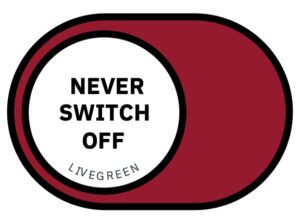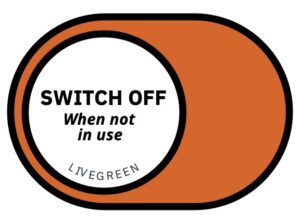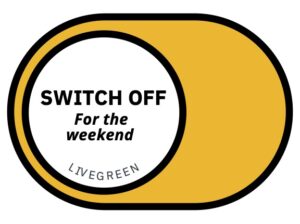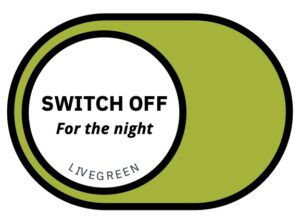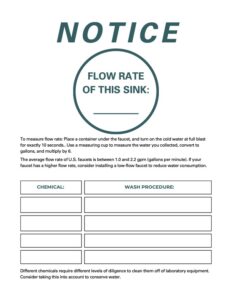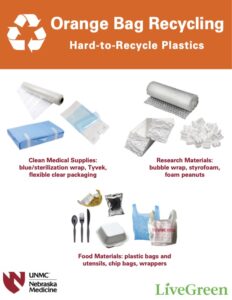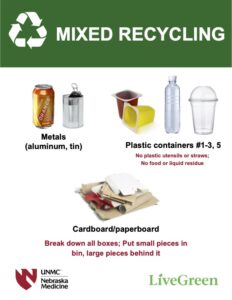Green Labs Program
Overview
To meet the med center’s sustainability goals and to align with the NU System’s sustainability targets, the Office of Sustainability launched a Green Labs program. The mission of the Green Lab program is to provide a common-sense and obtainable approach for our laboratory and research spaces to achieve excellence in innovation and safety by driving meaningful reductions in energy, water, and waste, and promoting responsible purchasing.
The med center’s world-class research drives breakthroughs that improve lives across Nebraska and beyond. By collaborating with providers, our researchers accelerate discoveries and deliver life-changing therapies to patients. With $268.8 million in research expenditures (2024), 1,485 active projects, and 523 faculty investigators, the med center is tackling today’s most critical medical challenges while shaping the next generation of healthcare leaders.
Research spans bench science labs, translational centers, and clinical trials, all supported by state-of-the-art facilities. The Omaha campus boasts over 740,000 square feet of dedicated research space, and the med center’s core facilities provide dozens of shared technologies and services to advance innovation.
As a researcher, you can positively contribute to our research mission —join the Green Labs program today!
Impacts
Laboratories present a higher demand for resources compared to other building space types, accounting for a larger percentage of organizational spending and subsequent impact.
- Laboratories have 5 to 10 times higher energy use intensity than standard office spaces and a five times higher water use intensity.
- The waste generated in a wet lab setting is numerous and varied. Unlike standard office spaces, laboratories can produce multiple types of hazardous waste, including chemical waste, infectious (biohazard) waste, and/or pathological (large tissue) waste, all of which present challenges to store and process.
- Laboratory researchers produce around 15 times the amount of plastic waste compared to the average individual, estimating a total of 5.5 million tons of plastic waste in a single year from labs.
- Across the med center, 1,344 staff members interact with labs as part of their job function
Advantages
Benefits of participating in the Green Lab program:
- Reduce operating costs by using resources more responsibly
- Added competitive edge in applying for federal grants
- Attracts new and innovative research
- Foster a culture of sustainability to accelerate action supporting institutional sustainability goals
Commitment to Sustainability
Med Center Sustainability Goals
In 2017, the med center approved and instituted six sustainability goals that explicitly address human and environmental health. Four of these goals align with the highest impact areas for laboratories.
- Emissions: Net zero building emissions by 2030.
- Progress: 26.1% reduction
- Cumulative savings: Since 2010, the med center has saved 304,000 metric tons of carbon dioxide equivalent (MtCO2e), equivalent to emissions from 38,293 homes for a year.
- Water: Net zero water by 2030.
- Progress: 10.9% reduction
- Cumulative savings: Since 2012, the med center has saved approximately 349,000,000 gallons of water—equivalent to 529 Olympic-sized swimming pools.
- Materials: Net zero waste by 2030.
- Progress: 21% diversion rate
- Cumulative savings: 29.5 million pounds of waste diverted from the landfill, equivalent to the weight of approximately 2,107 type II ambulances.
- Campus Engagement: Sustainability engagement score (SES) of 85.
- Progress: score of 58 as of Nov 2022
For more information on the med center’s sustainability goals, check out the dashboard.
Nebraska University System Sustainability Goals
In 2023, the Nebraska University (NU) System released a sustainability plan, driven by common-sense principles, to meet the needs of the present without compromising the ability of future generations to meet their own needs.
- Target 1: Double Student, Staff, and Faculty Sustainability Engagement and Cross-Campus Collaboration by 2027
- Target 2: Adopt Measurable Sustainability Goals and Publicize Annual Progress Reports
- Target 3: Maximize the University’s Facilities
- Target 4: Reinforce a Culture of Sustainable Procurement
For more information on NU System sustainability goals, check out their website.
Program Structure
The program is organized into four main pillars, each addressing the highest impact areas a lab can have on institutional sustainability goals. Program goals represent commonality among the pillars that participants strive to achieve, complementing the focused pillar goals.
Program Goals
- Increase awareness of institutional-level sustainability goals and opportunities for lab participation
- Provide feasible solutions to lab sustainability issues through collaboration, accountability, intelligent design, creativity, and innovation.
- Continue to find areas of improvement through reporting impact data and highlighting performance indicators.
- Participating labs do not see any noticeable decrease in their lab productivity
Pillar Goals
Energy
- Reduce lab plug load consumption
- Ensure lab personnel operate fume hoods according to manufacturer recommendations, maintenance schedules, and safety standards
- Increase adoption of best management practices for cold storage
Waste
- Increase lab diversion rate (including hazardous waste) by participating in campus programs and supplier take-back programs
- Reduce excess waste in labs
- Promote and expand equipment/resource-sharing culture among labs
Water
- Reduce consumption of both potable and purified water
- Increase purchase efficient water-consuming equipment and operate according to manufacturer recommendations
- Promote disposal behaviors that support water quality standards
Procurement and purchasing
- Increased adoption of sustainable procurement practices
- High demand/volume items have improved supplier redundancy to hedge against supply disruptions
- Adoption of lab source reduction strategies
For questions about the Green Lab program, reach out to greenlab@unmc.edu.
Printables to fulfill scorecard credits
Stickers
EE-11: Color Dot, Shut it Off (never) – Download PDF | 2.5″ x 1.73″ (kiss cut shape)
EE-11: Color Dot, Shut it Off (when not in use) – Download PDF | 2.5″ x 1.73″ (kiss cut shape)
EE-11: Color Dot, Shut it Off (for the weekend) – Download PDF | 2.5″ x 1.73″ (kiss cut shape)
EE-11: Color Dot, Shut it Off (for the night) – Download PDF | 2.5″ x 1.73″ (kiss cut shape)
EE-12: “Flip the Switch” sticker – Download PDF | 2.5″ x 1.5″
EE-14: Judicious use of ice – Download PDF | 3″ x 3″ (circle shape)
WA-7: Water use labeling – Download PDF | 5″ x 3.33″
8.5″ x 11″ standard paper, laminated
WW-9: Flow rate signage – Download PDF
WW-3: Orange bag recycling – Download PDF
WW-15/16: Recycling signage – Download PDF
For questions about mixed recycling on campus, please contact Rick Boldt at recycling@unmc.edu.


